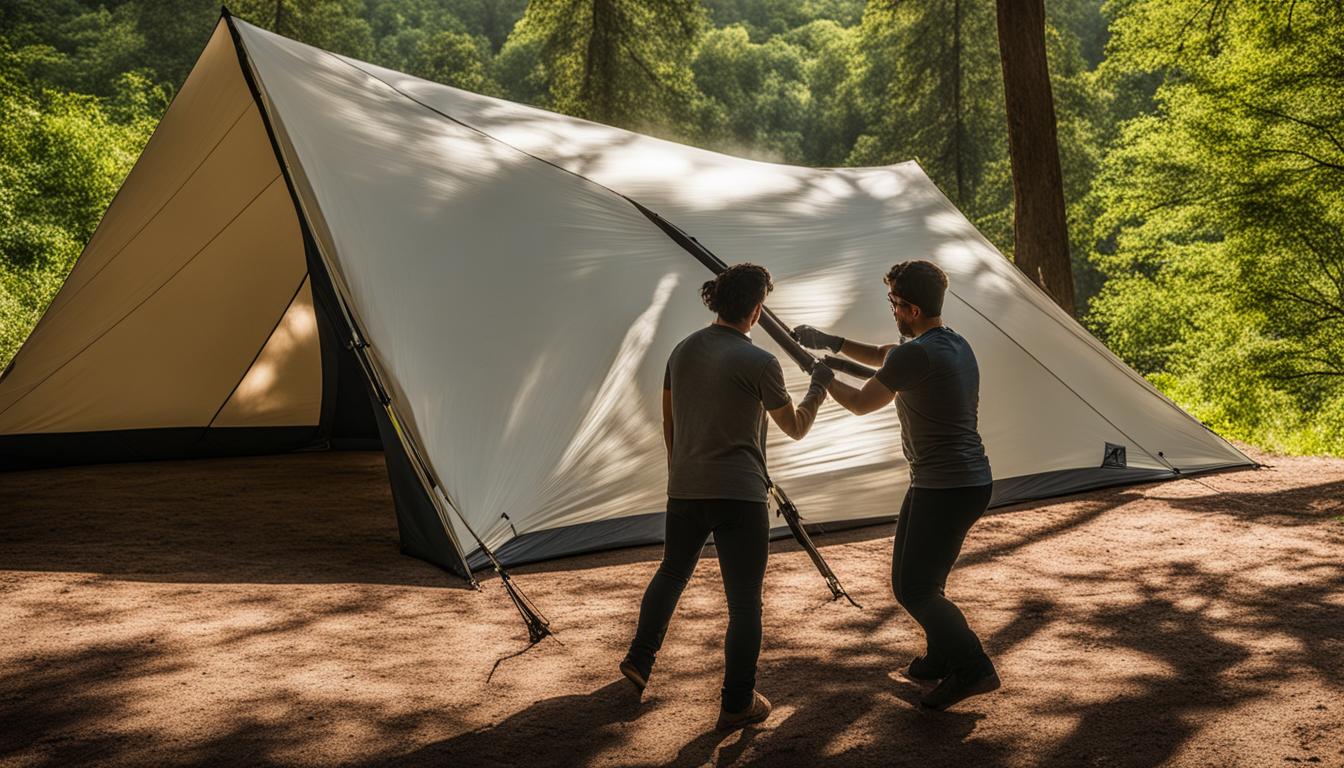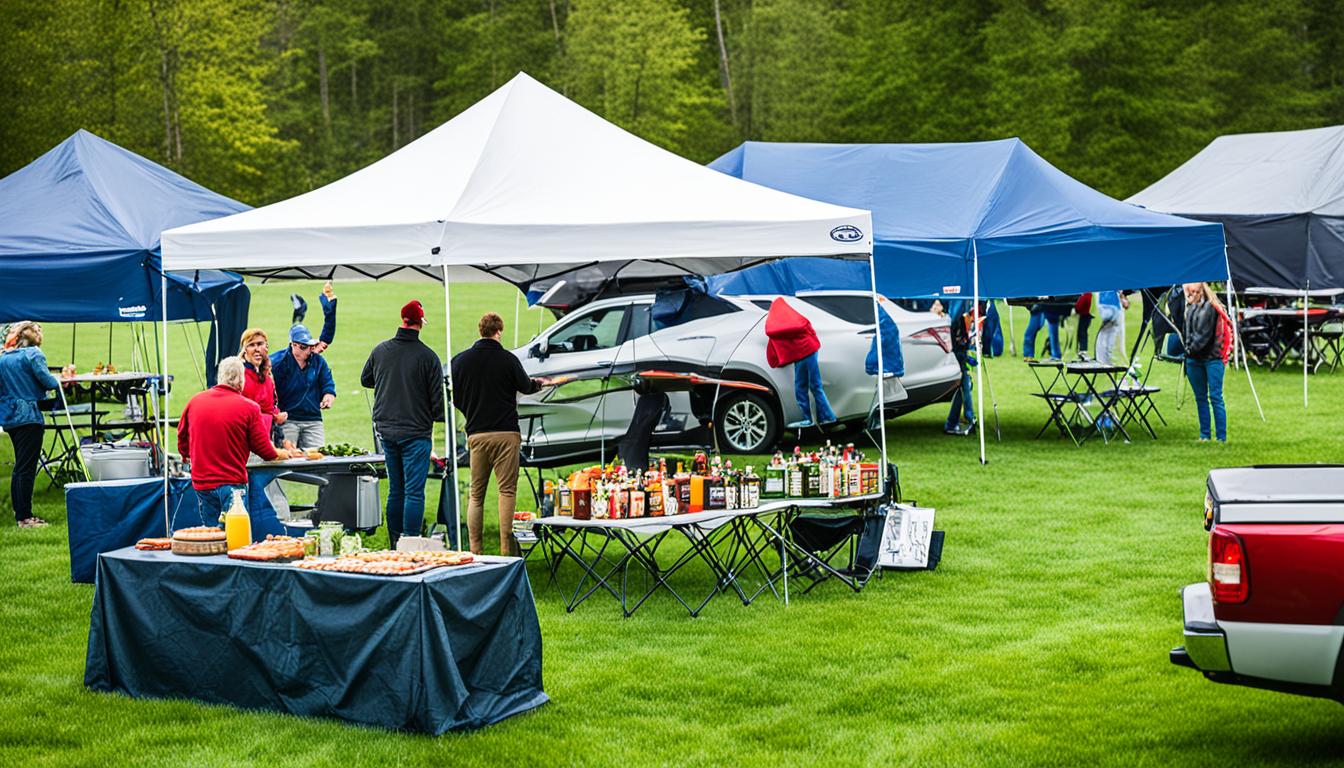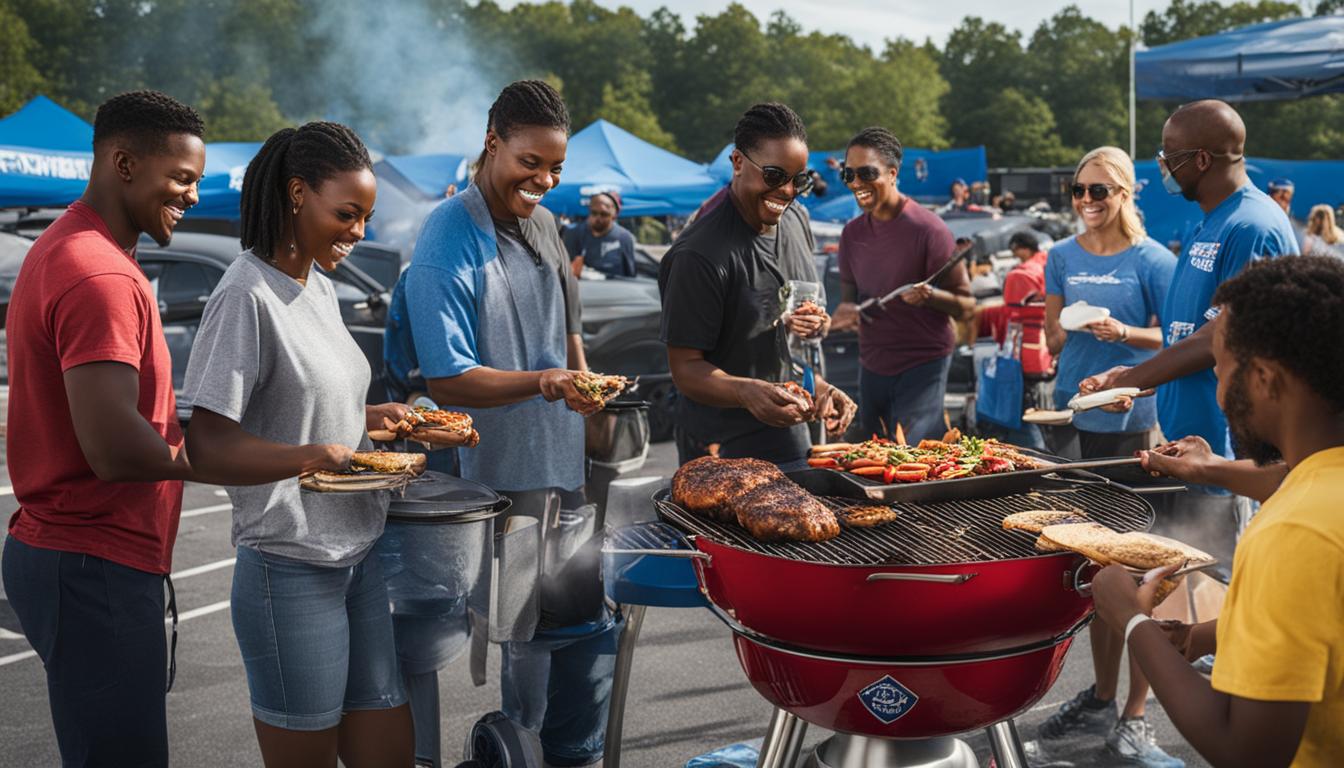
Canopy tents are a convenient option for providing shelter during outdoor events. To ensure a sturdy and hassle-free structure, proper setup is essential. In this article, we will provide you with valuable tips and a step-by-step guide for assembling a tailgate tent.
Setting up a canopy tent doesn’t have to be complicated. By following these tips, you can easily assemble your shelter and enjoy a secure and comfortable outdoor experience.
Starting with Proper Setup of Canopy Tent
Proper setup is the foundation for a secure canopy tent. Follow these steps to ensure a successful assembly:
- Begin by expanding the tent frame and ensuring all legs are set to the same height.
- Attach the fabric roof securely, ensuring it is properly aligned and centered.
- Double-check all tie-downs and fasteners to ensure a tight and secure fit.
- Follow the manufacturer’s instructions carefully to ensure proper tent frame setup.
By starting with the proper setup, you can lay a solid foundation for your canopy tent, ensuring its stability during your outdoor events.
Pro Tip: When attaching the tent roof, pay extra attention to the corners and edges to ensure a secure fit and prevent any gaps where rain or wind could enter.
Being Mindful of Your Terrain
The stability of your canopy tent greatly depends on the terrain it is set up on. To ensure a secure and reliable shelter, it is important to choose a suitable location that is well-suited for your tent setup.
Select a location with even ground to prevent any tilting or leaning of the tent. Uneven terrain can compromise the stability and balance of the structure, increasing the risk of accidents. Additionally, it is crucial to avoid areas prone to slant or water accumulation, as soggy ground can make the tent unstable and more susceptible to damage.
When choosing a location, also consider the proximity of trees or bushes. Setting up your tent near these natural elements can pose a risk to the fabric and structure during strong winds. Falling branches or rubbing against branches can cause tears or punctures, compromising the tent’s integrity. It is advisable to maintain a safe distance from such hazards.
By being mindful of your terrain and selecting a suitable location, you can ensure a safer and more secure canopy tent setup. Now, let’s move on to other important aspects of shelter assembly.
img src=”https://seowriting.ai/32_6.png” alt=”canopy tent setup on uneven terrain”
Using Sturdy Canopy Tent Stakes – Steel is an Excellent Choice
Tent stakes are an essential component for securing your canopy tent. When it comes to choosing the right tent stakes, investing in high-quality steel stakes is a wise decision. Steel stakes offer several advantages that make them an excellent choice for securing your tent.
- Durability: Steel tent stakes are known for their durability and long-lasting performance. They can withstand various weather conditions, including strong winds and heavy rain, without bending or breaking.
- Strong hold: Steel stakes provide a stronger hold in the ground due to their sturdy construction. This ensures that your tent will stay securely in place, even in challenging outdoor environments.
- Proper attachment: It’s crucial to choose steel stakes that have hooks or loops for proper attachment to the tent legs. These features allow for a secure and reliable connection, minimizing the risk of the tent coming loose.
To enhance the stability of your canopy tent, it’s important to hammer the steel stakes firmly into the ground. This ensures that they are securely anchored and can withstand external forces. Remember to choose stakes that are long enough to provide sufficient anchoring depth.
Using steel tent stakes is a practical and effective way to secure your canopy tent. Their durability, strong hold, and proper attachment features make them a reliable choice for any outdoor event or camping trip.
With sturdy steel stakes, you can have peace of mind knowing that your canopy tent is securely anchored, allowing you to enjoy your outdoor activities without worrying about the tent’s stability.
Setting Up on Concrete or Asphalt? Use Tent Weights
When it comes to setting up a canopy tent on concrete or asphalt, traditional stakes are not an option. However, there’s no need to worry! You can still securely anchor your tent using tent weights. These innovative accessories provide the necessary stability to prevent your tent from swaying or sliding, even on hard ground.
One popular option is to use durable synthetic sandbags with strong Velcro straps. These sandbags are designed to withstand various weather conditions and are easy to attach securely to your tent. They provide a reliable and convenient solution for securing your tent on concrete or asphalt surfaces.
Another alternative is to use sand-filled buckets tied to the tent frame. These buckets are an effective and cost-friendly way to add extra stability to your canopy tent. Simply fill the buckets with sand, tie them securely to the tent legs, and enjoy enhanced peace of mind knowing that your tent is firmly anchored.
No matter which option you choose, tent weights offer a practical and reliable solution for securing your canopy tent on hard ground. With their use, you can confidently set up your tent without worrying about it being affected by the lack of traditional stakes.
Adding Anchors for Extra Reinforcement
In situations where you require extra stabilization for your canopy tent, consider using tent anchors. These durable straps can be attached to the tent’s frame and anchored to stakes or nearby structures. Properly fasten the anchors to create balanced tension and supplement the existing stakes or weights.
Using tent anchors provides additional stability to your canopy tent, making it more resistant to strong winds and unexpected shifts. Whether you’re setting up your tent for a beach party or a camping trip, anchors offer the peace of mind that your shelter will remain secure.
When utilizing tent anchors, it’s important to choose high-quality materials that can withstand outdoor conditions. Look for anchors that are made from sturdy nylon or polyester straps, ensuring they won’t fray or break under pressure.
Properly fastening the tent anchors is key to their effectiveness. Make sure to attach them tightly to the tent’s frame and secure them firmly to the ground or nearby structures. This will help distribute the tension evenly and reinforce the stability of your canopy tent.
By using tie down ropes and straps as tent anchors, you can ensure that your canopy tent stays securely in place, even in challenging weather conditions. These anchoring solutions offer an added layer of protection and stability, allowing you to enjoy your outdoor activities without worrying about your tent collapsing or getting damaged.
Remember, when choosing tent anchors, consider the specific needs and environment of your setup. Beaches, campsites, and windy areas may require different anchor systems to achieve optimal stability. Consult the manufacturer’s recommendations or seek professional advice to select the most appropriate anchors for your canopy tent.
With the proper use of tent anchors, you can enhance the stability and longevity of your canopy tent, creating a safe and reliable shelter for any outdoor event. Don’t overlook this important step in the setup process and ensure that your tent is anchored down properly for a worry-free experience.
Mitigating Water Damage with Canopy Tent Accessories
Water damage can pose a significant risk to the structural integrity and longevity of canopy tents. From mold growth to fabric damage, the consequences of water infiltration can be costly and time-consuming to address. Fortunately, there are several tent accessories available that can help mitigate the risk of water damage and ensure the longevity of your canopy tent.
Water-Resistant Vinyl Roofs and Sides
Investing in water-resistant vinyl roofs and sides is an effective way to prevent water damage to your canopy tent. These accessories are designed to repel moisture and prevent it from seeping into the fabric. With a water-resistant vinyl roof and sides, you can enjoy peace of mind knowing that your canopy tent is well-protected against inclement weather conditions.
Additional Sides
Adding extra sides to your canopy tent can provide an extra layer of protection against water. These additional sides can be securely attached to your tent, creating a barrier that prevents rainwater from entering the space. With the added protection of extra sides, you can ensure that your canopy tent remains dry and comfortable, even during heavy downpours.
Rain Gutters
Rain gutters are another valuable accessory for water protection. They are designed to collect and channel rainwater away from your tent, preventing it from pooling or seeping through the seams. By installing rain gutters, you can effectively divert water away from your canopy tent, reducing the risk of water damage and ensuring a dry and pleasant environment inside.
Tent Flooring
Tent flooring can provide an additional layer of protection against water infiltration. By elevating your tent off the ground with a durable and waterproof flooring system, you can prevent water from seeping in through the bottom. Tent flooring also helps create a clean and comfortable surface for your event, so you don’t have to worry about wet or muddy ground affecting your experience.
Cleaning and Drying
Properly cleaning and drying your tent before storage is crucial in mitigating water damage. After each use, make sure to remove any dirt, debris, or moisture from your tent. Allow it to air dry completely before folding and storing it in a dry and well-ventilated area. This will help prevent the growth of mold and mildew and prolong the lifespan of your canopy tent.
By investing in water-resistant vinyl roofs and sides, using additional sides and rain gutters, and ensuring proper cleaning and drying, you can effectively mitigate the risk of water damage to your canopy tent. These accessories provide an extra layer of protection against the elements and help maintain the longevity and functionality of your outdoor shelter.
Always Choose Quality
When it comes to canopy tents and accessories, quality is of utmost importance. Investing in high-quality materials ensures durability, longevity, and a reliable shelter for your outdoor events. Look for well-reviewed products that are made from premium materials such as aluminum or coated steel frames and weather-resistant vinyl fabrics.
By choosing a canopy tent with a custom design, you can ensure a perfect fit and a visually appealing appearance. A custom canopy adds a touch of professionalism and attention to detail to your setup.
However, it’s not just the materials that matter; proper setup is equally crucial. Make sure your tent is set up by knowledgeable individuals who understand the intricacies of professional tent setup. This will help prevent complications and ensure a secure and reliable shelter that can withstand different weather conditions.
By selecting quality canopy tents and paying attention to the materials used and professional tent setup, you can enjoy peace of mind knowing that your shelter is built to last.
| Benefits of Choosing Quality Canopy Tents |
|---|
| 1. Durability |
| 2. Longevity |
| 3. Reliable shelter |
| 4. Professional appearance |
| 5. Peace of mind |
Conclusion
Proper setup and securing methods are crucial for the assembly of a sturdy and hassle-free canopy tent. By following the step-by-step guide and valuable tips provided in this article, you can ensure a successful assembly process.
When setting up your canopy tent, always consider the terrain you’re placing it on. Choosing an area with even ground, free from slants or water accumulation, will enhance the structural stability of your shelter.
Whether you’re using sturdy stakes or tent weights, ensure that your canopy tent is properly anchored. Stakes made of high-quality steel will provide a strong hold, while tent weights are a practical solution for setting up on concrete or asphalt surfaces.
For added reinforcement, consider using tent anchors. These durable straps can be attached to the tent’s frame and anchored to stakes or nearby structures, creating balanced tension and maximizing stability.
Remember to prioritize safety and always choose high-quality materials for your canopy tent. Investing in well-reviewed products made from durable materials like aluminum or coated steel frames and water-resistant vinyl fabrics will ensure a reliable and long-lasting shelter.
With these shelter assembly tips in mind, you can confidently set up your canopy tent for any outdoor event. Enjoy the convenience and comfort it provides while knowing that it’s securely installed and ready to withstand various weather conditions.

Ryan Conlon is a passionate football fan and the driving force behind “Home Tailgate Party.” Ryan’s love for the game, combined with his culinary expertise, has led to a treasure trove of game day recipes and strategies. Whether you’re a seasoned tailgating pro or a rookie looking to up your game, Ryan’s insights and delicious recipes will help you score big at your next tailgate.








